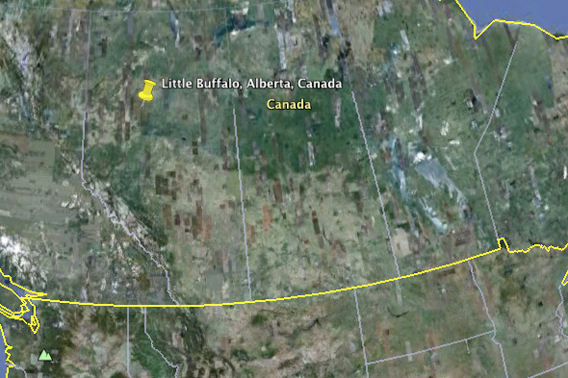
Google Earth view of location of Little Buffalo, Alberta near site of oil spill. Yellow line is the Canadian border with the US.
The Canadian province of Alberta has suffered its worst oil spill in 35 years with 28,000 barrels of oil (over a million gallons) spilling from a ruptured pipeline operated by Plains Midstream Canada in the Canadian boreal forest. The spill has sullied wetlands near Peace River, but was partially contained by a beaver dam and several small bodies of water according to the AFP.
“Good thing they had that beaver dam on there, eh? If they wouldn’t have had that beaver dam, God knows where that oil would have flowed. Probably down to Lubicon Lake. It’s not far from there,” William Whitehead, chief of the Woodland Cree, told the Edmonton Journal. The oil spill happened in the historical territory of the Cree’s Lubicon Lake Nation.
Although the dam helped stemmed the oil flow, the beavers didn’t make it. Six beavers and ten ducks were euthanized due to contamination.
Environmentalists say the spill could take years to clean up.
“I wouldn’t be surprised if clean up takes more than a year or two. There will be a lot of soil and vegetation that will be saturated with oil,” Chris Severson-Baker, managing director of a Canadian energy and environment think thank, told the Edmonton Journal.
Residents of Little Buffalo, Alberta from the Lubicon Lake Nation complained of health issues after the incident. The town lies about 4 miles from the spill. But Canada’s Energy Resources Conservation Board (ERCB) air monitoring system found levels of hydrocarbons were within accepted limits. Alberta’s environment minister Rob Renner has apologized to the Cree indigenous nation for the spill.
“I think we all could have done a better job—government and industry—in communicating with the local communities,” Renner said this weekend, also complementing Plains Midstream Canada for its current clean-up effort involving 300 workers.
While oil began leaking on April 29th, Plains Midstream Canada did not issue a statement for nearly a week and initially said only a few hundred barrels worth of oil had spilled. It also barred leaders from the Lubicon Lake Nation from filming inside the spill area. The company has since apologized for its response.
Green Party leader Elizabeth May said the spill brings up questions regarding adequate monitoring of Plains Midstream Canada, whose record she called “dismal”.
“The other unanswered question is whether officials tried to keep the Plains Midstream spill out of the news until after the election,” May said as reported by Global Toronto.
On May 2nd Canada’s Conservative Party, known as huge supporters of Canada’s oil industry, won a majority government. Canada is pushing to build a new pipeline through the US carrying oil from its infamous tar sands to the American market. The tar sands have been dubbed the by some as the world’s largest industrial source of greenhouse gases.
Related articles
Oil sands pollution in Canada worse than industry and government claim
 (12/07/2009) Canada’s tar sands have been internationally criticized as one of the world’s largest industrial sources of greenhouse gases, but the energy-intensive extraction of oil also has a less-noted impact on the local environment. A new study shows that the Alberta’s oil sands are likely releasing more PACs (polycyclic aromatic compounds) into nearby Athabasca River and its tributaries than the industry-funded and government-supported Regional Aquatics Monitoring Program (RAMP) has reported.
(12/07/2009) Canada’s tar sands have been internationally criticized as one of the world’s largest industrial sources of greenhouse gases, but the energy-intensive extraction of oil also has a less-noted impact on the local environment. A new study shows that the Alberta’s oil sands are likely releasing more PACs (polycyclic aromatic compounds) into nearby Athabasca River and its tributaries than the industry-funded and government-supported Regional Aquatics Monitoring Program (RAMP) has reported.
Has Canada become the new climate villain (yes, that’s right, Canada)?
 (12/02/2009) In 2007 American delegates to a climate summit in Bali were booed outright for obstructing a global agreement on climate change. Then in a David versus Goliath moment they were famously scolded by a negotiator from Papua New Guinea, Kevin Conrad. “If for some reason you are not willing to lead, leave it to the rest of us. Please get out of the way,” Conrad told the American delegates. However, much has changed in two years: the United States, under a new administration, is no longer the climate change pariah. The US has recently announced emissions cuts, negotiated successfully with China on the issue, and will be attending—Obama included—the Climate Change Summit in Copenhagen next week. Obama and his team probably don’t need to worry about being booed or remonstrated this time around, but that role may instead go to Canada.
(12/02/2009) In 2007 American delegates to a climate summit in Bali were booed outright for obstructing a global agreement on climate change. Then in a David versus Goliath moment they were famously scolded by a negotiator from Papua New Guinea, Kevin Conrad. “If for some reason you are not willing to lead, leave it to the rest of us. Please get out of the way,” Conrad told the American delegates. However, much has changed in two years: the United States, under a new administration, is no longer the climate change pariah. The US has recently announced emissions cuts, negotiated successfully with China on the issue, and will be attending—Obama included—the Climate Change Summit in Copenhagen next week. Obama and his team probably don’t need to worry about being booed or remonstrated this time around, but that role may instead go to Canada.
Canada at Copenhagen: “delay, obstruction, and total inaction”
(12/21/2009) Canada was the biggest obstructer at the Climate Change conference in Copenhagen, according to the Climate Action Network (CAN) an organization made-up of 450 NGOs. On Friday CAN awarded Canada the ‘Colossal Fossil Award’ for doing the most to obstruct an ambitious climate change agreement and for doing the least to mitigate climate change.







